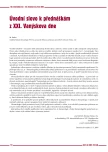Autoimmune haemolytic anaemias
Authors:
J. Čermák
Authors‘ workplace:
Ústav hematologie a krevní transfuze, Praha, ředitel prof. MUDr. Pavel Klener, DrSc.
Published in:
Vnitř Lék 2005; 91(7 a 8): 881-885
Category:
128th Internal Medicine Day - 21rd Vanysek's Day Brno 2005
Overview
Immune hemolytic anemia results from a dysregulation of cooperation between T‑ and B‑lymphocytes in a process of „self tolerance“ of autologous antigens. Antibodies of IgG‑subtype lead to the hemolysis at 37 ºC which is mainly extravascular, an optimal temperature for hemolysis of IgM subtype antibodies is 4 ºC and the hemolysis may have either intravascular or extravascular character. The agent evoking hemolysis is often undetectable, a part of immune hemolytic anemias may occur as a secondary disease in the course of infections, inflammations, autoimmune disorders or tumors. An antiglobulin test represents an essential tool for diagnosis of immune hemolytic anemia; the patients are mostly treated with corticosteroids as a single agent or in combination with other immunosuppressive agents (cyclophosphamide, cyclosprorin A). New treatment approaches (eg. i.v. immunoglobulins or rituximab) are indicated in patients resistant to conventional treatment. Severe hemolytic anemia represents a life threatening disease requesting a complex treatment at the intensive care unit.
Key words:
anemia - hemolytic - immune - diagnosis - treatment - immunosuppression
Sources
1. Berentsen S, Ulvestad E, Gjortsen BT et al. Rituximab for primary cold agglutinin disease: a prospective study of 37 courses in therapy in 27 patients. Blood 2004; 103: 2925-2938.
2. Berney T, Shibata T, Merino R et al. Murine autoimmune hemolytic anemia resulting from Fc gamma receptor-mediated erythrophagocytosis: protection by erythropoietin but by interleukin-3, and aggravation by granulocyte-macrophage colony-stimulating factor. Blood 1992; 79: 2960-2964.
3. Mackay IR. Tolerance and autoimmunity. BMJ 2000; 321: 93-96.
4. Ring GH, Lakkis FG. Breakdown of self-tolerance and the pathogenesis of autoimmunity. Semin Nephrol 1999; 19: 25-33.
5. Samuelsson A, Towers TL, Ravetch JV. Anti-inflammatory activity of IVIG mediated through the inhibitory Fc receptor. Science 2001; 291: 484-486.
6. Zilow G, Kirschfink M, Roelcke D. Red-cell destruction in cold agglutinin disease. Infusionther Transfusionsmed 1994; 21: 410-415.
Labels
Diabetology Endocrinology Internal medicineArticle was published in
Internal Medicine

2005 Issue 7 a 8
Most read in this issue
- Post transfusion reactions
- Thrombocytosis and thrombocythemia
- Antiphospholipid syndrome – diagnosis and treatment
- Anemia of chronic disease
